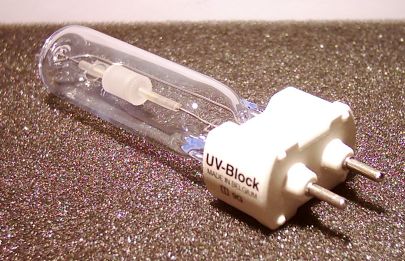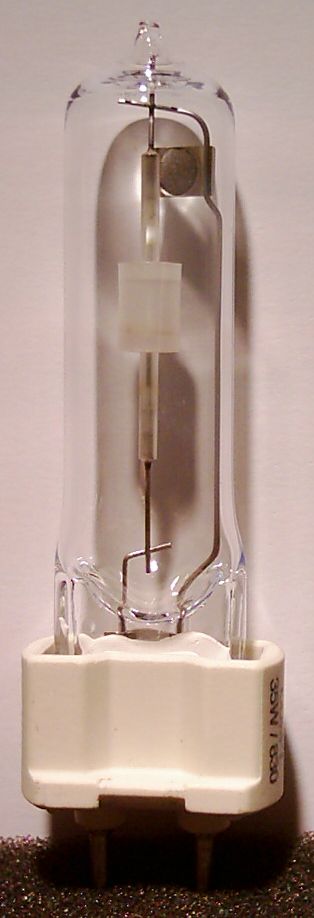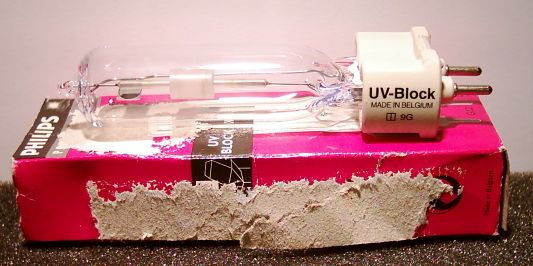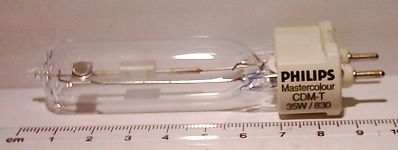
| Manufacturer: | Philips |
| Model: | Mastercolour CDM-T 35W/830 |
| Primary Application: | Display, architectural or industrial lighting. |
| Ballast Type: | Philips MHC 035 S/50 |
| Wattage: | 35W |
| Diameter (max): | 18mm |
| Length: | 100mm |
| Electrode gap: | 5mm |
| Bulb/Tube material: | Outer: UV-Stop Quartz. Inner: ceramic |
| Colour Temperature: | 3000°K |
| Peak output wavelength: | N/A - Broadband emission. |
| Total light output: | 3300Lm |
| Rated lifetime: | 12'000 Hours. |
| Cap: | G12 |
| Operating voltage: | 90V |
| Striking voltage: | 5KV Max |
| Operating current: | 0.85A |
| Warmup/restrike time: | 3 minutes/15 minutes maximum. |
| Cost (original): | Unknown |
| Value (now): | Unknown |
| Place of manufacture: | Belgium |
| Date of manufacture: | July 1999 |
The use of ceramics in metal halide lamp construction
has long been recognised as having many advantages - namely that it is
more resistant to chemical attack by the halide salts present within
the lamp, and that it is able to withstand higher temperatures than the
equivalent quartz structure. The greater corrosion resistance
also allowed adequate lifetimes to be reached without requiring as
thick (and heavy) a wall on the arc tube. This meant that ceramic
arc tubes had a smaller thermal mass, allowing lamps to run up/re-strike
more rapidly than their quarts equivalents. It was not a design
without at least some problems to overcome however - not least figuring
out how to get a metallic conductor into the ceramic arc tube to carry
the discharge. The conventional metals for doing this (usually
niobium, such as found in the similar arc tubes used in high pressure
sodium lamps) can not be used, as they are rapidly attached by the
halide salts at the operating temperatures of the arc tube.
Philips however were the first to come up with a truly practical
solution, which resulted in the launch of their CDM range of lamps in
1994. The design was so successful that 15 years on, virtually
all ceramic metal halide lamps are still using arc tubes in some way
based on the Philips CDM design. The key to this success was to
move the fragile seals as far away from the intense heat of the arc as
possible, therefore reducing their temperature and as a result the rate
of attack. The very long seal region also allows the seal to be
made of conventional niobium wire tucked away in a thin enough tube
that the halide salts cannot diffuse towards the seal reasons.
The
style of lamp shown below was the first of the CDM range to come on the
market, and the excellent quality of light produced and variety of lamp
styles and ratings which have since become available have ensured that
it proved to be very much a success for Philips.
I actually use
one of these lamps in an up-lighter in the corner of my room as one of
the main sources of light. In normal use, the colour really is
quite hard to distinguish from a good halogen source of the same colour
temperature (well, unless you get the diffraction grating out anyway!).
There
are a number of lamps in the CDM family which can be operated in an
open fixture, this however is not one of them, and must be operated in
a suitably rated fixture which is fully capable of containing any
fragments of lamp in case the arc tube should rupture, resulting in a
lamp explosion at the end of life. This is unlikely during the
normal lifetime of the lamp if operated as specified - however if the
lamp is operated beyond its rated lifetime (usually indicated by a
sudden shift in colour, a lamp becoming hard to start, or flickering),
it becomes ever more likely.
Note: This page dates from 2005...as such the photos are the best that my cheap 2003 digital camera could manage - I do hope to update these with something you can't count the pixels in at some point.

Philips Mastercolour CDM-T 35W/830 Compact Metal Halide Lamp - General overview

Philips Mastercolour CDM-T 35W/830 Compact Metal Halide Lamp - Lamp Cap

Philips Mastercolour CDM-T 35W/830 Compact Metal Halide Lamp - Detail showing lamp structure

Philips Mastercolour CDM-T 35W/830 Compact Metal Halide Lamp Lamp Packaging

Philips Mastercolour CDM-T 35W/830 Compact Metal Halide Lamp - Showing size of lamp
This page last updated:
19th June 2023: Changes to page formatting to improve readability on mobile devices. Also some background code changes to improve search engine behaviour.